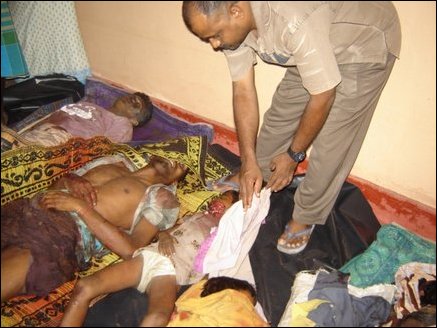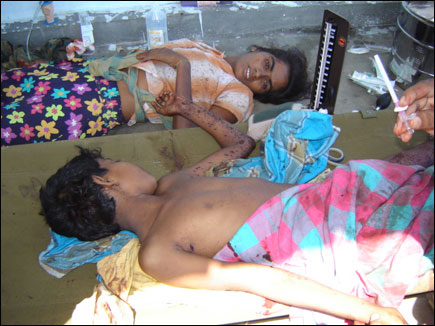INTERNATIONAL FRAME &
THE STRUGGLE for Tamil Eelam Sri Lanka's Strategy of Terror has International Backing
[together with comment by tamilnation.org] Tamil Guardian, 15 November 2006
Sri Lanka’s Sinhala dominated state is escalating its military campaign to destroy the Tamil struggle. As it does so, its contempt for the Ceasefire Agreement (CFA) and international humanitarian law is undisguised. As ever, there are two components to Sri Lanka’s strategy – attacking the Liberation Tigers on the one hand and inducing terror amongst the Tamil populace on the other. These elements have always been part of counter-insurgency in Sri Lanka. And they have always had the approval of the international community.
Despite its rhetoric of multi-ethnic plurality the reality is the state of Ceylon/ Sri Lanka has, since independence, functioned on the logic of us-and-them when it comes to the Sinhalese and the Tamils. And the 2002 peace process has pointedly failed to corrode this racial hierarchy. The state’s response to the devastation wrought by the 2004 tsunami – to ignore the Northeast and prioritise the South – is archetypical. The point was underscored last week by a frustrated Operation USA.
But it is the state’s escalating violence against the Tamil population that is doing most to illuminate contemporary ethnic relations in the island. Sri Lanka’s artillery targeted a refugee camp in Vakarai. At least 40 people were killed and 100 wounded.  
As ever, mimicking justifications of atrocities in another part of the world, Sri Lanka said it was counter-attacking LTTE gun positions – a claim rejected by international ceasefire monitors and human rights groups who spoke to survivors and residents. But the Army also blocked the ICRC and other aid agencies from the area for several hours. It refused to let the badly wounded civilians out to reach hospital. And for the past six months, the Sri Lankan military has been brazenly blocking food, medicine and other essentials to Vakarai and other Tamil region. The protests of international aid agencies, Tamil parliamentarians and human rights groups have been derisively ignored.
And apart from meting out this collective punishment against Tamils in areas controlled by the Tigers, in its own controlled areas, the state is waging a murderous campaign against anyone even slightly inclined to agitate against it. It is not simply a matter of LTTE cadres or supporters, but anyone dabbling in Tamil political activity. It is inevitable perhaps that parliamentarians of the Tamil National Alliance (TNA) are targets for the Army-backed paramilitaries and death squads.The assassination of Nadaraja Raviraj, MP, last Friday is, as his colleagues say, an attempt to silence their vocal criticism of the state. But it is more than that. The killing, and the wider campaign of terror, is intended to send a message to the wider Tamil community that it is the state, not the international community or the LTTE that controls their fate. The begrudging and feeble criticism of Sri Lankan atrocities by the international community is shameful and revealing. It confirms what the Tamil sceptics have always said about the Norwegian peace process – that it is an exercise in counter-terrorism, rather than conflict resolution, that it is about hamstringing the LTTE and bolstering the state, rather than ensuring a just solution. Comment by tamilnation.org see also Dr.S.Sathananthan in A to Z of Conflict Resolution in Sri Lanka, 22 September 2004 "..At first intermittent "talks" with the national movement are mooted to legitimise the State's military onslaught as unavoidable and indeed made necessary by the "lawlessness" of the national movement. But when a military stalemate ensues, then "talks" become the continuation of war by other means. Having failed to disarm the national movement through force, the State then manoeuvres to draw the movement into "talks" with the principle objective of forcing it to decommission weapons. This continuation of war by other means is the so-called "peace process". If armed conflict is the power struggle at the military level, "peace process" is the power struggle at the political level..."
In the past few years, there has been much public berating and lecturing to the LTTE about human rights, child rights, political assassinations and so on. But now these formerly strident voices have gone silent.
The point is that these international principles are raised only when they serve to undermine the Tamil struggle, but not when Tamils are victims. After all, we remember the approving international silence during the ‘war for peace.’ Those days are back. Dozens of ordinary Tamils are being murdered each week.  
Tens of thousands are being harried daily by military bombardment. Hundreds of thousands of our people are suffering shortages of food and medicine.
And it is the international community’s tacit collusion in this onslaught that we must come to terms with. The Sri Lankan state is behaving in the same manner it always has. As President Junius Jayawardene blithely observed in July 1983: “The more you put pressure in the north, the happier the Sinhala people will be here. Really, if I starve the Tamils out, the Sinhala people will be happy.” What the Tamils need to understand is that if such brutality against our people will result in us abandoning our demands for our political rights then the international community will also be happy. Which is why there has been no real pressure on Sri Lanka to desist. Which is why the international response to Sri Lankan violence against us is a mocking call for the state to investigate and punish itself. Which is why, even now, there is no international diplomacy to avert the violence. by tamilnation.org The question that the Tamil people will increasingly ask is: why is it that the international community seeks to avoid supporting the struggle of the people of Tamil Eelam to be free from alien Sinhala rule? Here see Nadesan Satyendra in Sri Lanka - Tamil Eelam: Getting to Yes, 27 October 2006 "...In an important sense for the past 25 years and more, it will be true to say that two conflicts have raged in the island of Sri Lanka. One is the conflict between the Tamil people and the Sinhala people... We need to examine the interests behind the stated positions of the US and India. We need to do so despite the apparent preference of the US as well as India to advance their interests by asserting that they are disinterested good Samaritans concerned simply with bringing peace to a troubled island. But the facts belie these assertions. We need to address the strategic interests of the US and India because the political reality is that a conflict resolution process in relation to the Tamil Eelam-Sri Lanka conflict will not succeed without resolving the US-India conflict in the Indian Ocean Region.... Stated broadly, US foreign policy is directed to build on its current position as the sole surviving super power and secure a unipolar world (with a 'multi polar perspective' - a la Condoleezza Rice) for the foreseeable future. And this means, amongst other matters, preventing the rise of independent regional hegemons. On the other hand, the central plank of New Delhi's foreign policy is to deny any independent intermediary role to extra regional powers in the affairs of the Indian region and also to further the emergence of a multi lateral world. In this latter objective, New Delhi may count on the 'calibrated' support of the European Union, Russia, China and Iran amongst others. Given the difference in the end goals that US and India have, it should not be surprising if the policies of the United States and New Delhi in relation to Sri Lanka and the LTTE are not always congruent. But that is not to say that the United States will not cooperate with India. It will. It will seek to cooperate 'as a super power' - and the US believes that it has sufficient instruments in its armoury to do just that. One such instrument is the Norwegian sponsored Peace Process. This explains the consistently enthusiastic support that the Peace process has received from the United States and the more muted (and calibrated) support from India. This also helps us understand the covert operations of RAW in Tamil areas in the island of Sri Lanka and the material support extended by India to Sinhala governments and Sri Lanka political parties. In the 1980s, RAW gave covert material and financial support to the Tamil militants to secure the same end - Indian hegemony in the Indian Ocean region. It appears that New Delhi's interests remain permanent, though its 'friends' may have changed from time to time. Because New Delhi does not have the clout of a super power, it seeks to manage the Tamil struggle to progress its own ends by infiltrating the Tamil struggle - both in Tamil Eelam and abroad. That is what it did in 1980s and that is what it is doing today. Today, both India and the US state openly that they are intent on securing the territorial integrity of Sri Lanka. They do not do so because of some generalised statist disdain for the emergence of new states. Did the international community have the same 'statist disdain' in the case of Croatia? Or for that matter in the case of Latvia, Lithuania and the Ukraine? The reason is to be found in the specific strategic concerns of the US and India in relation to the Indian region. And we need to understand the inter play if we are to progress the conflict resolution process in Sri Lanka. ...The uneasy power balance in the Indian Ocean region must be assessed in the light of "...two geopolitical triangles juxtaposing on the Indian Ocean's background: U.S.-India-China relations and China-Pakistan-India relations. In this complicated geopolitical configuration, New Delhi is not simply a partner of China or the United States: India is emerging as a major power that follows its own grand strategy in order to enhance its power and interests..." India's Project Seabird and the Indian Ocean's Balance of Power - PINR, 2005 - more
|